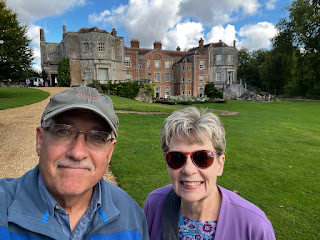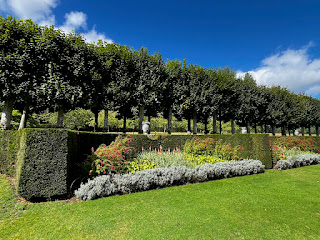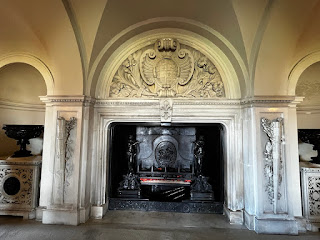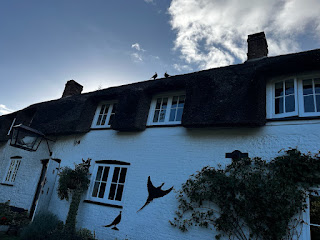Greetings! Marty and I are on a new adventure, this time exploring the southwest section of Great Britain as we make our way to the southwest corner of Cornwall.
We landed at 8:30 am and within short time, we were set up with a rental car, with Marty breezing along the highway as we made our way southwest to the National Trust site, Mottisfont. Because Marty and I are Royal Oak members, who partner with the Trust, I generally use our membership as an opportunity to explore their various chosen gems. (Not to mention that we visit at no cost!)
You can see that it was a beautiful day with lots of bright sunshine, and the temperatures were quite comfortable, which was certainly a pleasant surprise!
The back of the property had some lovely gardens,
and the stable yards featured some interesting sculptures.
But what makes this house unique, is that it was once an active religious community, run by Augustinian monks. The Black Death significantly diminished members, and, it eventually was a casualty of King Henry VIII's proclaimed Dissolution.
The king gifted the priory to William, Lord Sandys, his Lord Chamberlain. The king stipulated that recipients of these once holy properties, had one year to make improvements, or he would take the property back into his own hands.
Lord Sandys chose to modify the priory by incorporating it into a house to avoid demolition which was all too common. He was able to begin in short time to appease the king.
He designed and built a huge Tudor mansion on the surrounds of the original priory, encapsulating much of the structure within the walls. There were several rooms that featured a window sized cut out in the wall, where one could view the original granite stone building that was hiding beneath. In this particular room, there was a small stained glass window above the door.
Outside, tucked in a corner in the front of the house, stands this graceful mosaic of an angel, hidden from view of the casual bystander.
On the bottom floor there is the kitchen, where one can enjoy an afternoon Cream Tea, which is a common Trust Treat to enjoy.
Believe me, functioning on a few hours of sleep, with virtually no breakfast, this was a much appreciated delight!
On the top floor of the house there are special galleries, which represent various themes throughout the year. Presently, the rooms are devoted to books written and illustrated by John Birmingham. Among those features were "Mr. Grumpy", "Borka", and some other well loved children's books.
I couldn't get over how the rooms had been transformed to entice children who would certainly be eager to read the copies of what they were viewing on the walls.
So much intricate detail stenciled and painted right on the walls! All to be removed and replaced with something different in the near future.
I must say, I was quite impressed at the thought, talent and time that would have gone into these showcases.
By now, our tour was complete, and we decided to forego the walk to the fly fishing hut, and head to our next destination. Which, I must say, is becoming a bit of an issue, as we have little cell service to help us maneuver in the right direction. And, the road atlas dated the year 2000, could probably use an update.
But, we finally had our directions ready, and began the journey to Kingston Lacy in Dorset, another National Trust venue. As is typical with so many of these houses, we needed to ignore the GPS and follow the brown signs which eventually led us to the parking area.
Around the corner, along the walk, this magnificent building stands.
It was originally the home of Sir John Banks, and his wife, Mary who were Charles the I sympathizers. Because of their loyalty to Charles I, their home, Corfe Castle, which is a few miles south, was blown up during the English Civil War, forcing Mary to flee north, since the castle was then in ruins, taking her children with her.
Sir John Banks built the structure that now stands, although there were several stages of remodeling over the years. It was gifted to the National Trust in 1981.
Walking in through the front door, one is greeted by this magnificent fireplace.
Down the hall, in a solarium, stand three large statues
one is a statue of Lady Mary Banks, holding a key in her hand
and here sits Charles I, sitting upon a shield carved with the likeness of Corfe castle prior to its destruction. (It's difficult to see in the photo, but the engraving was quite detailed.)
Charles sees this view every day, when the windows are let open.
Pretty awesome, don't you think?
The agreement made with the National Trust stated that the art collection in the house was to remain intact, without being split up. Several of the owners were avid art collectors, adding pieces over the years from famous artists. The result is more like that of a museum than a home.
I asked about the keys hanging on the two plaques on the wall, and I was told that the keys came from Corfe castle. Once the castle was destroyed, there was no need for the keys, as there were no doors to open and close. And, so, the items were kept by the family members, and now hang as a reminder of the destruction.
This house holds a vast collection of various painting purchased strictly as art collections, along with other segments, such as these painted door panels, designed by William John Banks, a dependent of Sir John.
The young woman in the center of this canvas, would marry into the banks family, and bring a dowry that would pay for many of the future renovations that were made.
And the beautiful girl with the pearl necklace, had eyes that followed me as I walked down the hall.
I wish I knew how the artist managed that trick!
A marble staircase was added in the mid 1800s, replacing the original set of wooden stairs. William John Banks was a world traveler who sought to add the beauty of the world into the family residence.
And it's quite apparent that he did just that.
Many of these alterations were begun by Willam John Banks as early as 1834. Not only did he have a vision for improving the beauty of the house, he also had a passion for travel and made the journey to Egypt several times as a young man.
On the bottom floor of the building, these Egyptian stones stand on shelves, within easy view of the visitor. There are dozens of them. At first, I though that they were copies, but when I asked, I was told that the house holds an extremely impressive collection of Egyptian items, that were discovered hidden away when the Trust bought the property.
Egypt is aware that these treasures are on display here and the country is proud to have them protected in such a stately home.
One of the odd items in this same room, is an actual crocodile head, which has been converted into a bank. There is a large, gold slit on the bottom where his tongue would have been. I can't help but wonder if there are some coins in there? Does anyone want to take a gander?
Downstairs, in the kitchen, the top of the one wall is lined with bells that lead to the various rooms of the house. Most are familiar with this type of feature, particularly if one is a Downton Abbey or Upstairs/Downstairs fan. But, these are unique bells, as each one of them has a tiny pendulum that swings when the bell rings, and continues to vibrate back and forth for several minutes. Let's face it, the only purpose of such a design is to hold the servants accountable. There could be no excuse stating that one heard the wrong bell ringing.
We headed out the back door, and towards the garden entrance. As you can see, the back looks equally impressive.
There were some lawn chairs for relaxing, but I wasn't sure I'd be able to get back up and out of it, so I passed.
An obelisk stands a distance from the house. It dates from several hundred years BC, and has quite an inscription on it. We were told the story that the structure was in a boat on the river, nearby, but due to its weight, it collapsed the boat and was immersed in the water for two years until William John had it removed, and transported to the ground where it now stands.
The inscription on the plate has some verbiage complaining about taxation. In 2000 years BC. Guess some things never change!
By now, we'd completed quite a full day, considering that we were pushing through on just a few hours of sleep. So, we once again struggled with the GPS, but finally managed to find the route to our B&B.
We're here just one night. And, that's a good thing, because this place has to be the most "in the middle of nowhere" that we've ever seen.
It states that it's in the village of Plush.
I'm pretty sure that sign is the center of town. The circle on the top says "Plush". And, there's really not much else here, but the Brace of Pheasants, which, as you can see, are well represented.
Surprisingly enough, the pub was full of people for dinner. And it's not too surprising as the place has an excellent chef. No disappointment there!
I'm off to bed. Need to catch up on that beauty sleep!





































